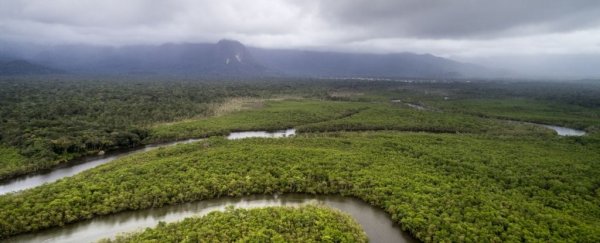The Amazon rainforest is on track to get a whole lot less rain over the coming century.
Even if deforestation is completely halted, research has found a global rise in carbon dioxide could still jeopardize the climate above the world's largest tropical rainforest.
According to new simulations, a 50 percent rise in global CO2 emissions has the power to reduce rainfall in the Amazon by a drastic amount, possibly equivalent to what would occur if the entire forest was cut down and replaced with pastures.
Obviously, those are extreme scenarios, but they indicate what may happen if we do nothing to change our behavior.
"To our surprise, just the physiological effect [of CO2] on the leaves of the forest would generate an annual fall of 12 percent in the amount of rain [252 millimeters less per year], whereas total deforestation would lead to a fall of 9 percent [183 mm]," says ecologist David Montenegro Lapola from the University of Campinas (UNICAMP) in Brazil.
"These numbers are far higher than the natural variation in precipitation between one year and the next, which is 5 percent."
As we speak, it seems deforestation and CO2 emissions are leading to reduced moisture above the Amazon, although in slightly different ways.
On the one hand, deforestation means fewer leaves, which are the main source for gas exchange during photosynthesis. When a leaf opens up its pores or stomata to 'breathe in' CO2 and 'breathe out' oxygen, it also releases water vapor into the atmosphere.
This ultimately contributes to the clouds above the trees, and thus, the rain that pours from those very clouds. If there are fewer leaves in the forest, there will be less moisture in the air.
CO2 concentrations have a slightly different effect. As this greenhouse gas increases, the stomata remain open for shorter time periods. This means they also emit less vapor into the atmosphere, leading to a simultaneous reduction in cloud cover and rainfall.
The results of the new study align with previous research, which also found a rise in CO2 would reduce rainfall in tropical South America's forests (and lead to increased rainfall for forests on other continents).
The results of this previous study also suggest the Amazon is particularly vulnerable to rising CO2, even more so than forests in Asia or Africa. When the Amazon produces less water vapor, then water vapor from the Atlantic Ocean also has fewer clouds to join up with, and this means all that moisture could blow right over the forest to the Andes instead.
While these regions get showered with more rain than before, the tropical rainforests of South American could begin to dry out. If there's less moisture in the air to absorb heat, researchers think it could lead to higher local temperatures.
Such findings make it clear that local action in the Amazon is simply not enough. Ultimately, the future climates and ecosystems of tropical South America will depend on a global reduction in CO2 emissions, and not just a few countries cleaning up their act.
We're in this together.
The study was published in Biogeosciences.
